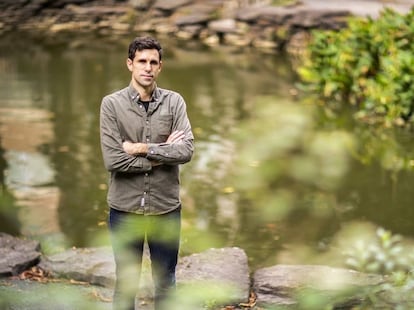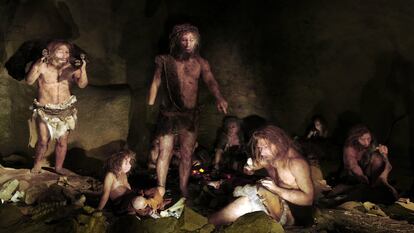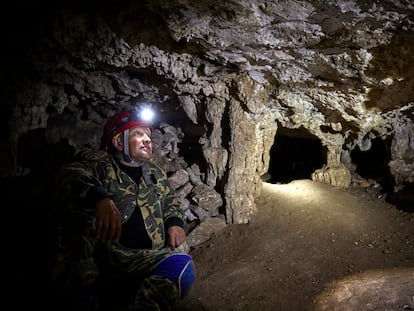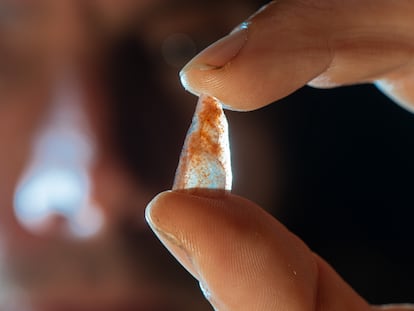The scientist who ‘resurrects’ Neanderthal molecules to find new antibiotics
A University of Pennsylvania research team led by Spaniard César de la Fuente is using artificial intelligence to bring extinct human biological material back from the dead

“We will be dying from antibiotic-resistant bacterial infections in the next 10 to 20 years,” says geneticist Edith Heard. The World Health Organization (WHO) has long warned of the threat posed by microorganisms impervious to existing drug treatments, which by the year 2050 will kill an estimated 10 million people every year — surpassing the lethality of cancer. One of the people on the front lines of the battle against antibiotic resistance is César de la Fuente, winner of the Princess of Girona Award for scientific research and a professor of bioengineering at the University of Pennsylvania. De la Fuente combines artificial intelligence and the expertise and experience of his research team, the Machine Biology Group, to discover and analyze thousands of molecules with antibacterial potential. The team looks for life-saving specimens in natural compounds, like wasp venom, or in the human body’s own protein map. And now, in the ancient DNA of our Neanderthal and Denisovan ancestors, “resurrecting” molecules lost by Homo sapiens over the course of our evolution.
There are more bacterial cells in the body than human cells. Among the most relevant attributes of bacteria — the most abundant organisms on the planet, responsible for everything from generating dental plaque to maintaining the fertility of the earth — is their ability to develop resistance to antibiotics. This impressive feat, however, threatens the lives of millions of people.
De la Fuente’s team is searching for compounds to respond to this challenge. Analyzing the proteome — the complete set of proteins in the body — these researchers have discovered 2,603 peptides (molecules made up of amino acids) with biological functions unrelated to the immune system, yet possessing anti-infective traits.
De la Fuente, 37 years old and from the Spanish port city of A Coruña, is included on the Forbes Top 50 Awarded Spaniards List and has been recognized as a distinguished researcher by the American Chemical Society and the Massachusetts Institute of Technology. His team, he explains, works with a process known as “de-extinction,” or the recovery of compounds from the past that no longer exist. “We developed an algorithm to explore the human proteome as a source of antibiotics and have found many such sequences, which we call encrypted peptides,” he says. “This led us to posit that these sequences had been produced throughout evolution and played a role in the immune system to defend us from invading or infectious agents, such as bacteria. So we decided to investigate the proteome of our closest ancestors, which are the Neanderthals and Denisovans.”

The base proteome was made public thanks to Svante Pääbo’s research on ancestral DNA that won last year’s Nobel Prize for identifying the genetics of extinct humans. “What we did,” says De la Fuente, “was develop an algorithm to explore these data — these human proteomes — to see if we could find antibiotics encoded in the proteins.”
De la Fuente says the concept was inspired by the movie Jurassic Park. “The idea of the movie was to bring entire organisms — dinosaurs — back to life. But that poses a lot of ethical, ecological and technical problems. Today, we don’t have enough genomic information to resurrect a dinosaur. Instead, we came up with the idea of molecular de-extinction: rather than resurrect a whole organism, we’re trying to revive molecules from the past to help us solve present-day problems, such as antibiotic resistance.”
The team’s research, published in the journal Cell Host & Microbe and reviewed by Nature, uses genomic and proteomic information from mitochondrial DNA, with the help of an algorithm designed by the team and the use of artificial intelligence, to find molecules that could be used as potential antibiotics.
“The most fascinating moment was when we resurrected the molecules using a method known as solid-phase chemical synthesis,” De la Fuente says. “We use the code the computer provides us about amino acids with antibiotic capacity to make the machines synthesize the molecules chemically.”
The results were verified experimentally by exposing the resurrected molecules (four peptides from Homo sapiens, one from Homo neanderthalensis and one from Denisova hominins) in Petri dishes, and in mice affected by the bacterium Acinetobacter baumannii, a common cause of hospital infections. All six experiments showed positive effects, to varying degrees, some with an efficacy similar to that of current conventional antibiotics.
“The doses used were extremely high, but the idea is interesting,” Nathanael Gray, a chemical biologist at Stanford University uninvolved in the research, told Nature. Gray doubts there will be any immediate development of drugs based on the discovery of extinct compounds.
But De la Fuente says that the goal of the research is not only to find new antibiotics, but “new ways of thinking about how to discover new molecules using information from extinct organisms.” Molecular de-extinction, he says, “can help us open up new spaces that we had not explored before and this means that, perhaps, we can use the biology of our ancestors to learn more about ourselves, and about the potential of some molecules.”
Euan Ashley, an expert in precision genomics and health at Stanford University, agrees, “Diving into the archaic human genome is an interesting and potentially useful approach,” he says.

De la Fuente and his fellow researchers have spent half a decade searching wherever they think they might find a new weapon in the fight for human health: in the past and the present, in humans and in other lifeforms. One potentially beneficial discovery has come from the biological material found in the venom of the wasp Eumenes micado, according to a study published in Cell Reports Physical Science.
“Venom is a largely unexplored source of potential medicine, or of molecules with interesting functionalities,” says De la Fuente. “We’ve been looking at different poisons for a few years now to reprogram them and remove or eliminate the toxicity to take advantage of their antibiotic capacity.”
The key, he says, is in the combining of artificial intelligence tools, biotech robotics, and the experience and expertise of the Machine Biology Group. “Five years ago, the average time to discover an antibiotic was three to six years. Now we can discover thousands in the matter of a few hours or days,” he says.
Sign up for our weekly newsletter to get more English-language news coverage from EL PAÍS USA Edition
Tu suscripción se está usando en otro dispositivo
¿Quieres añadir otro usuario a tu suscripción?
Si continúas leyendo en este dispositivo, no se podrá leer en el otro.
FlechaTu suscripción se está usando en otro dispositivo y solo puedes acceder a EL PAÍS desde un dispositivo a la vez.
Si quieres compartir tu cuenta, cambia tu suscripción a la modalidad Premium, así podrás añadir otro usuario. Cada uno accederá con su propia cuenta de email, lo que os permitirá personalizar vuestra experiencia en EL PAÍS.
¿Tienes una suscripción de empresa? Accede aquí para contratar más cuentas.
En el caso de no saber quién está usando tu cuenta, te recomendamos cambiar tu contraseña aquí.
Si decides continuar compartiendo tu cuenta, este mensaje se mostrará en tu dispositivo y en el de la otra persona que está usando tu cuenta de forma indefinida, afectando a tu experiencia de lectura. Puedes consultar aquí los términos y condiciones de la suscripción digital.
More information
Archived In
Últimas noticias
Most viewed
- Sinaloa Cartel war is taking its toll on Los Chapitos
- Oona Chaplin: ‘I told James Cameron that I was living in a treehouse and starting a permaculture project with a friend’
- Reinhard Genzel, Nobel laureate in physics: ‘One-minute videos will never give you the truth’
- Why the price of coffee has skyrocketed: from Brazilian plantations to specialty coffee houses
- Silver prices are going crazy: This is what’s fueling the rally











































